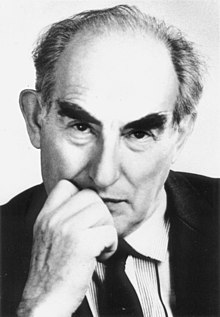
Back فيتالي غينزبورغ Arabic فيتالى جينزبورج ARZ Vitali Ginzburq Azerbaijani ویتالی لازاریویچ گینزبرگ AZB Гинзбург Виталий Лазаревич Bashkir Віталь Лазаравіч Гінзбург Byelorussian Віталь Гінзбург BE-X-OLD Виталий Гинзбург Bulgarian ভিতালি গিঞ্জবার্গ Bengali/Bangla Vitali Guínzburg Catalan
You can help expand this article with text translated from the corresponding article in Russian. (May 2019) Click [show] for important translation instructions.
|
Vitaly Ginzburg | |
|---|---|
Виталий Гинзбург | |
 | |
| Born | Vitaly Lazarevich Ginzburg 4 October 1916 Moscow, Russian Empire |
| Died | 8 November 2009 (aged 93) Moscow, Russia |
| Resting place | Novodevichy Cemetery, Moscow |
| Nationality | |
| Alma mater | Moscow State University (KN 1938) (DN 1942) |
| Known for | Ginzburg–Landau theory Ginzburg criterion Transition radiation Undulator |
| Spouse(s) | Olga Zamsha Ginzburg (1937–1946; divorced; 1 child) Nina Yermakova Ginzburg
(m. 1946) |
| Awards |
|
| Scientific career | |
| Fields | Theoretical physics |
| Institutions | P. N. Lebedev Physical Institute, Russian Academy of Sciences N. I. Lobachevsky State University of Nizhny Novgorod |
| Doctoral advisor | Igor Tamm |
| Doctoral students | Viatcheslav Mukhanov Leonid Keldysh |
Vitaly Lazarevich Ginzburg, ForMemRS[1] (Russian: Вита́лий Ла́заревич Ги́нзбург; 4 October 1916 – 8 November 2009) was a Russian physicist who was honored with the Nobel Prize in Physics in 2003, together with Alexei Abrikosov and Anthony Leggett for their "pioneering contributions to the theory of superconductors and superfluids."[2]
He spent his career in the former Soviet Union and was one of the leading figure in former Soviet program of nuclear weapons, working towards designs of the thermonuclear devices.[3][4] He became a member of the Russian Academy of Sciences and succeeded Igor Tamm as head of the Department of Theoretical Physics of the Lebedev Physical Institute of the Russian Academy of Sciences (FIAN). In his later life, Ginzburg become an outspoken atheist and was critical of clergy's influence in Russian society.[5]
- ^ a b Longair, M. S. (2011). "Vitaly Lazarevich Ginzburg. 4 October 1916 – 8 November 2009". Biographical Memoirs of Fellows of the Royal Society. 57: 129–146. doi:10.1098/rsbm.2011.0002. S2CID 71295700.
- ^ "The Nobel Prize in Physics 2003". Nobel Foundation. Retrieved November 9, 2009.
- ^ Thomas H. Maugh II (November 10, 2009). "Vitaly Ginzburg dies at 93; Nobel Prize-winning Russian physicist". Los Angeles Times.
- ^ Cite error: The named reference
ufnwas invoked but never defined (see the help page). - ^ Nikonov, Vyacheslav (September 30, 2004). "Physicists have nothing to do with miracles". Social Sciences (3): 148–150. Retrieved September 9, 2007.